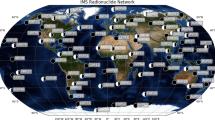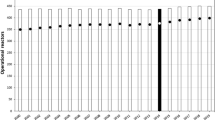Abstract
Between 13 and 22 May 2010, multiple detections of radionuclides were recorded at monitoring stations in Eastern Asia, including Okinawa, Takasaki (both Japan) and Ussuriysk (Russia). The stations are operated as part of the CTBTO international monitoring system (IMS) to record signals from nuclear tests. Additional detections were reported from a national monitoring post of the Republic of Korea located in Geojin close the border to the Democratic People’s Republic of Korea (DPRK). The scenario under investigation was unique in the history of the IMS. Possible source regions in the region and consistent release times were investigated. Subsequently, it was checked whether some known locations on the territory of DPRK could have been a possible origin of the fission products detected. As a result, it was found that two of the three DPRK locations investigated could be a possible source. It is evident, however, that the two events cannot be explained by one single release at one specific location and time. At least two releases with a time shift of about 1 day, possibly but not necessarily on the same location, are needed. Under the hypothesis that the source was in DPRK, the releases needed to explain the measurements would be about 1014 Bq for 133Xe and 5 × 1012 Bq for 140Ba. Taking all this into account and comparing the results with recently published hypotheses regarding a possible low-yield nuclear test in DPRK in May 2010, we conclude that such a test is indeed one of the possible scenarios from the meteorological point of view.








Similar content being viewed by others
References
CTBT (1996) Text of the comprehensive nuclear-test-ban treaty. See web page of the CTBTO. http://www.ctbto.org/the-treaty/treaty-text/
Hoffmann W, Kebeasy R, Firbas P (2000) Introduction to the verification regime of the comprehensive nuclear-test-ban treaty. Phys Earth Planet Inter 113:5–9
Schulze J, Auer M, Werzi R (2000) Low level radioactivity measurement in support of the CTBTO. Appl Radiat Isot 53:23–30
Werzi R (2009) The operational status of the IMS radionuclide particulate network. J Radioanal Nucl Chem 282(3):693–697
Kalinowski MB, Becker A, Saey PJR, Tuma M, Wotawa G (2008) The complexity of CTBT verification. Taking noble gas monitoring as an example. Complexity 14(1):89–99
Auer M et al (2004) Intercomparison experiments of systems for the measurement of Xenon radionuclides in the atmosphere. Appl Radiat Isot 60(6):863–877
Zaehringer M, Becker A, Nikkinen M, Saey P, Wotawa G (2009) CTBT radioxenon monitoring for verification: today’s challenges. J Radioanal Nucl Chem 282(3):737–742
De Geer L-E (2012) Radionuclide evidence for low-yield nuclear testing in North Korea in April/May 2010. Sci Glob Secur 20(1):1–29
Wotawa G, Becker A, Kalinowski M, Saey P, Thuma M, Zaehringer M (2010) Computation and analysis of the global distribution of the radioxenon isotope 133Xe based on emissions from nuclear power plants and radioisotope production facilities and its relevance for the verification of the nuclear-test-ban treaty. Pure Appl Geophys 167:541–557
Biegalski SR, Saller T, Helfand J, Biegalski KMF (2010) Sensitivity study on modeling radioxenon signals from radiopharmaceutical production facilities. J Radioanal Nucl Chem 284(3):663–668
Saey PRJ, Bean M, Becker A, Coyne J, d’Amours R, De Geer L-E, Hogue R, Stocki TJ, Ungar RK, Wotawa G (2007) A long distance measurement of radioxenon in Yellowknife, Canada, in late October 2006. Geophys Res Lett 34:L20802. doi:10.1029/2007GL030611
Steinhauser G, Lechermann M, Axelsson A, Böck H, Ringbom A, Saey PRJ, Schlosser C, Villa M (2012) J Radioanal Nucl Chem. doi:10.1007/s10967-012-1949-x
Ringbom A, Elmgren K, Lindh K (2007) Analysis of radioxenon in ground level air sampled in the Republic of South Korea on October 11–14, 2006, Swedish Defence Research Agency (FOI), Report FOI-R–2273-SE, 25 p
Ringbom A, Elmgren K, Lindh K, Peterson J, Bowyer TW et al (2009) Measurements of radioxenon in ground level air in South Korea following the claimed nuclear test in North Korea on October 9, 2006. J Radioanal Nucl Chem 282(3):773–779
Wotawa G, De Geer L-E, Denier P, Kalinowski M, Toivonen H, D’Amours R, Desiato F, Issartel J-P, Langer M, Seibert P, Frank A, Sloan Craig, Yamazawa H (2003) Atmospheric transport modelling in support of CTBT verification—overview and basic concepts. Atmos Environ 37:2529–2537
Stohl A, Hittenberger M, Wotawa G (1998) Validation of the Lagrangian particle dispersion model FLEXPART against large scale tracer experiment data. Atmos Environ 32:4245–4264
Stohl A, Forster C, Frank A, Seibert P, Wotawa G (2005) Technical note: the Lagrangian particle dispersion model FLEXPART version 6.2. Atmos Chem Phys 5:2461–2474
Acknowledgments
The work presented here was made possible by the Austrian Federal Ministry for European and International Affairs and the Austrian Federal Ministry for Science and Research as part of their funding for the National Data Centre of Austria (NDC-AT) for the verification of the CTBT.
Disclaimer
The views expressed in this paper are the views of the author and not necessarily shared or endorsed by the Austrian National Authorities in charge of the verification of the CTBT.
Author information
Authors and Affiliations
Corresponding author
Rights and permissions
About this article
Cite this article
Wotawa, G. Meteorological analysis of the detection of xenon and barium/lanthanum isotopes in May 2010 in Eastern Asia. J Radioanal Nucl Chem 296, 339–347 (2013). https://doi.org/10.1007/s10967-012-2012-7
Received:
Published:
Issue Date:
DOI: https://doi.org/10.1007/s10967-012-2012-7




